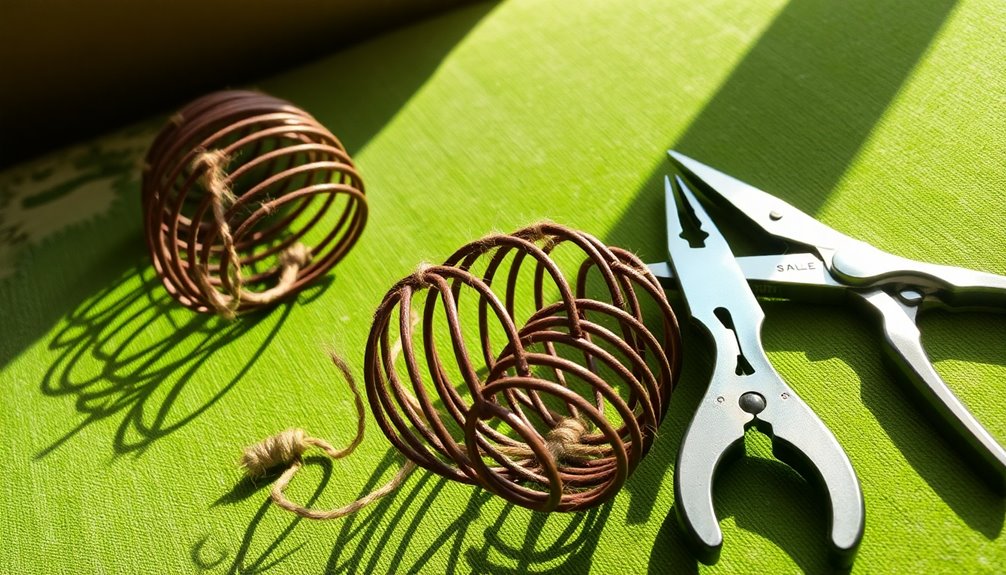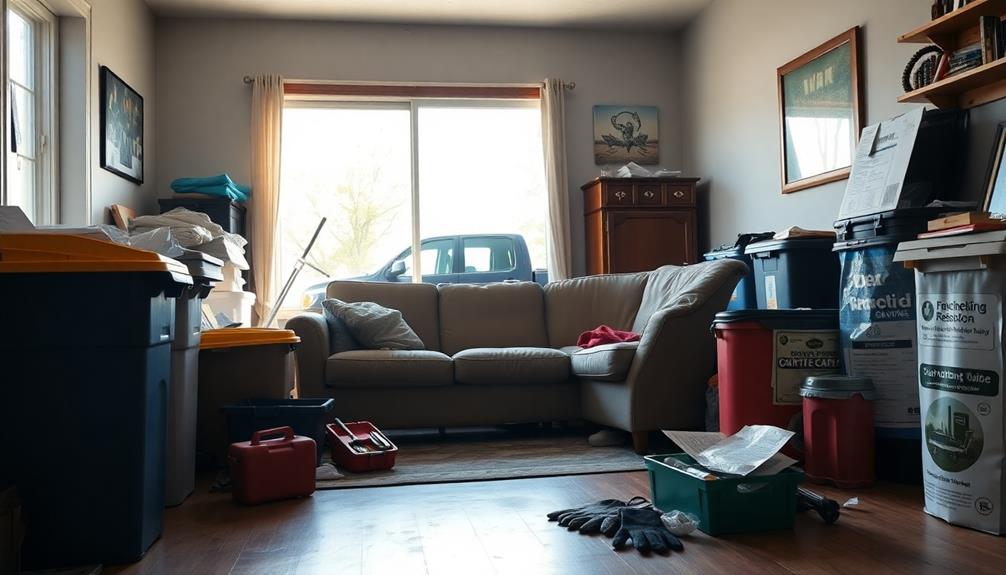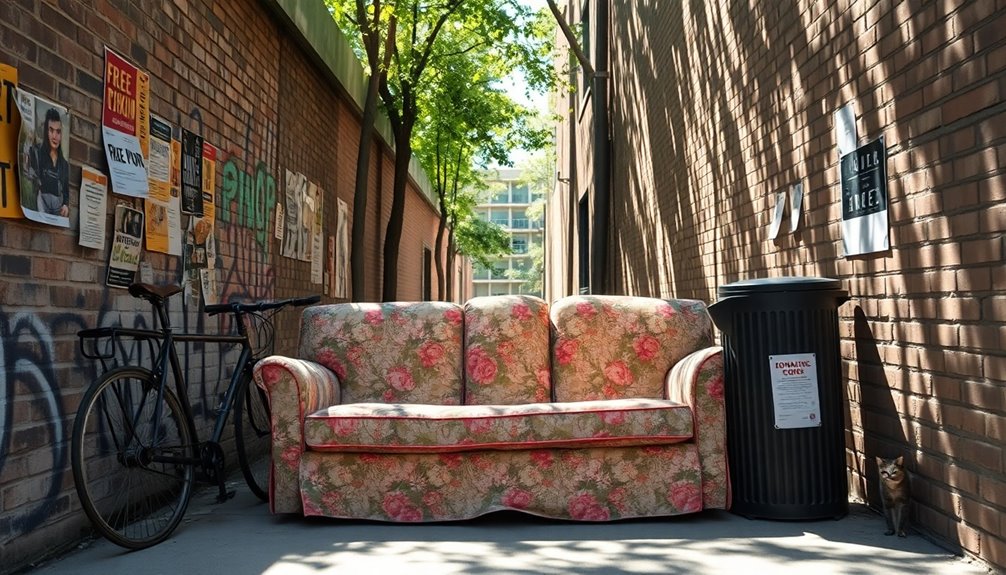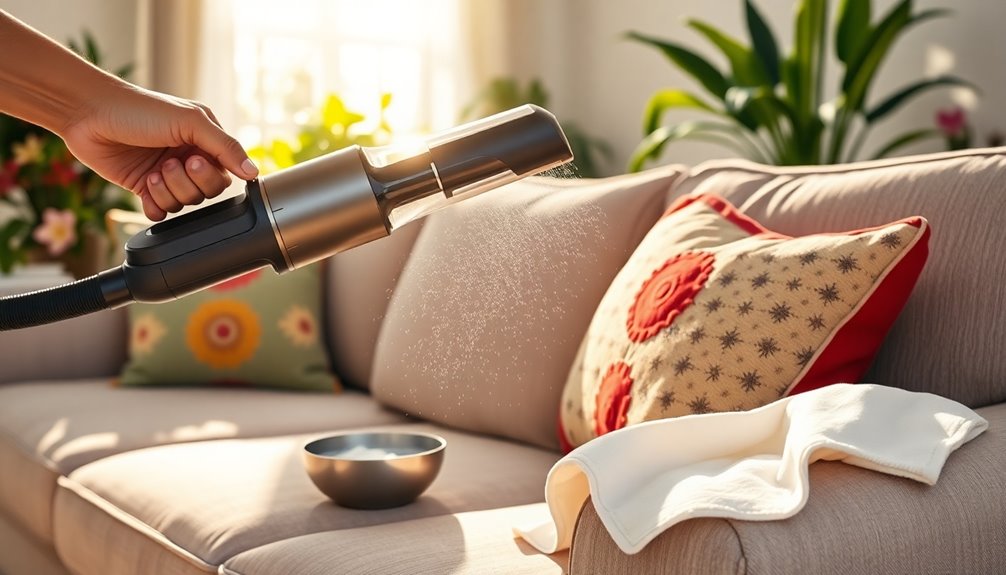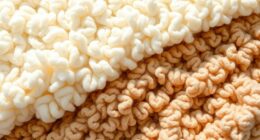To repair sofa springs, first, flip the couch and inspect the springs for wear or damage. Tighten any loose joints to ensure structural stability. Replace any worn springs with new ones, securing them properly to enhance support. If you notice sagging, consider adding some extra padding or using a sofa topper as a temporary fix. Regular maintenance, like vacuuming and cleaning, will prolong the life of your sofa. Don't forget to check the cushion density for added comfort. By doing these steps, you'll revive your sofa's comfort and support, and there's plenty more to explore for upkeep!
Key Takeaways
- Inspect the sofa frame and springs for visible damage or sagging before attempting any repairs.
- Tighten loose joints and connections to ensure springs are securely attached and functional.
- Replace worn or broken springs with new ones to restore comfort and support.
- Use wood glue or brackets to reinforce weak joints for improved structural integrity.
- Periodically check and maintain springs to prevent future issues and enhance longevity.
Introduction
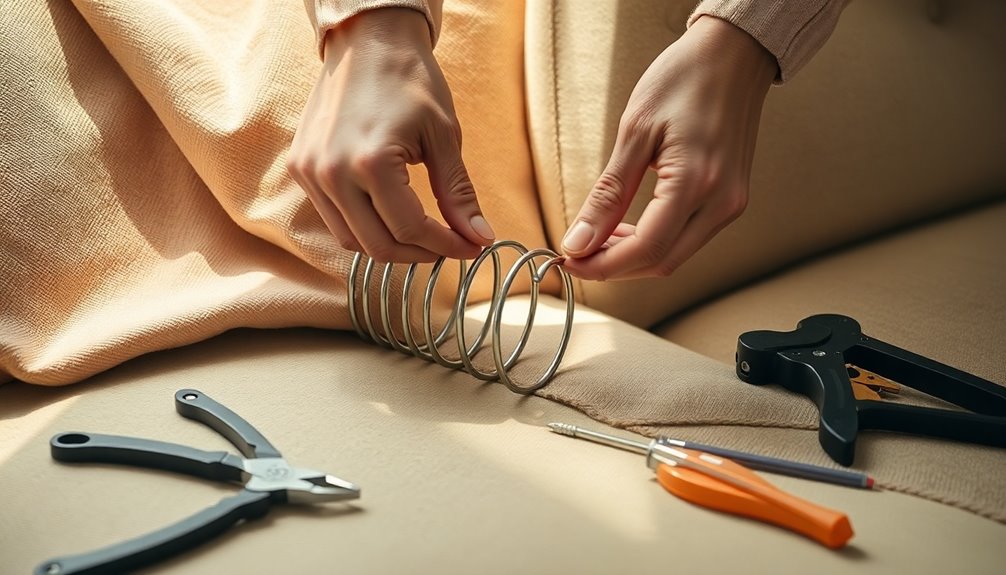
When you think about maintaining your sofa, don't forget about the fabric care. Regular cleaning and knowing the right techniques for specific materials can keep your couch looking fresh. Plus, if you have pets, addressing odors like urine promptly is crucial for a clean, inviting living space.
Routine Fabric Care
To keep your sofa looking its best and extend its life, regular fabric care is essential. Start by vacuuming your sofa fabric regularly to remove dust and debris, preventing them from settling into the fibers and causing wear and tear over time. When accidents happen, spot clean stains immediately with a suitable fabric cleaner, but remember to test it on a hidden area first to avoid discoloration. Additionally, consider using a fabric protector to create a barrier against spills and stains, which can make future clean-ups much easier. If your sofa does experience damage, researching repairing torn sofa fabric techniques can help you restore its appearance and functionality without the need for costly reupholstering. Regular maintenance combined with prompt attention to damage will ensure that your sofa remains a beautiful centerpiece in your living space for years to come.
Rotating and fluffing your cushions periodically is another key practice. This helps maintain their shape and prevents uneven wear, which can impact the underlying springs. Additionally, consider using a fabric protector spray. This creates a barrier against spills and stains, significantly extending the lifespan of your sofa's upholstery.
Always follow the manufacturer's care instructions for cleaning and maintenance to preserve the fabric's integrity and warranty. By incorporating these simple yet effective routines into your regular cleaning schedule, you can keep your sofa looking fresh and new, reducing the likelihood of damage and ensuring comfort for years to come. Taking these steps will save you from costly repairs down the line.
Fabric-Specific Cleaning Techniques
Understanding how to care for your sofa extends beyond routine fabric maintenance; it's vital to know the specific cleaning techniques for different materials. Each type of fabric has unique requirements. For instance, velvet needs a gentle touch, so use a soft brush to avoid damaging the fibers. Leather, on the other hand, should be cleaned with a damp cloth and a specialized leather cleaner to maintain its luster.
Always check the care label before cleaning. It'll tell you if the fabric is machine washable, dry clean only, or if it requires spot cleaning. Natural fibers like cotton and linen usually wash well with mild detergent, while synthetic fabrics may need a gentle cycle with lower heat settings in the dryer.
When dealing with stains, act fast! Blot the area with a clean cloth and choose appropriate stain removers that match the fabric type. For example, vinegar works well on cotton, while you'll need specialized cleaners for silk. Regular maintenance, like vacuuming and applying fabric protectants, can also prolong the life of your sofa fabric and make future cleanings easier. Additionally, utilizing a vacuum with HEPA filters can help capture allergens that may accumulate in your sofa fabric.
Eliminating Pet Urine Smell
Eliminating pet urine smell from your sofa can feel like a daunting task, but with the right approach, you can restore freshness. Start by promptly blotting the affected area with paper towels to absorb as much liquid as possible. This initial step is crucial to prevent the stain from setting deeper into the fabric.
Next, mix equal parts vinegar and water in a spray bottle. Spray this solution onto the stain and let it sit for 10-15 minutes before blotting again. Vinegar effectively neutralizes odors. After treating with vinegar, sprinkle baking soda over the area to absorb any remaining moisture and odors. Leave it on for several hours, then vacuum it up.
To ensure a complete clean, rinse the area with clean water to remove any residue left from the vinegar and baking soda. If the smell persists or if you're dealing with deep-set stains, consider buying enzymatic cleaners specifically designed to break down pet urine. These cleaners target the source of the odor, guaranteeing a thorough clean and a fresher sofa. With these steps, you'll be well on your way to eliminating unwanted pet odors.
Sofa Care for Young Kids

When you have young kids, choosing the right sofa fabric is crucial. You'll want to opt for pet-resistant and washable covers to handle spills and wear. Additionally, using protective fabric covers can help keep your sofa looking great despite the chaos of everyday life. Consider integrating smart home devices that can assist in maintaining a clean environment, such as smart vacuums that can manage daily messes.
Pet-Resistant Fabric Choices
Choosing the right fabric for your sofa is crucial, especially in homes with pets and young kids. You'll want to explore pet-resistant fabric choices that can withstand the wear and tear of everyday life. Look for materials labeled as "pet-resistant" or "durable," such as microfiber, leather, or synthetic blends. These fabrics are designed to endure scratches and spills.
Fabrics with tight weaves or patterns can effectively hide stains and scratches better than lighter or single-toned materials. Additionally, consider opting for water-resistant or stain-resistant treatments to provide extra protection against spills and accidents, making cleanup a breeze.
Darker colors or busy patterns are also great choices, as they help disguise pet hair and dirt, minimizing the appearance of messes created by your furry friends or little ones. Regularly brushing or vacuuming pet hair and addressing spills promptly will maintain the integrity of the fabric and keep your sofa looking newer for longer. By selecting the right pet-resistant fabric choices, you can enjoy your sofa without worrying about damage from playful kids or pets. Furthermore, understanding the importance of cost-cutting strategies can help you make budget-friendly choices when investing in quality fabrics.
Opt for Washable Fabric Covers
For families with young kids, opting for washable fabric covers can make a significant difference in maintaining your sofa's appearance. When spills and stains happen, which they inevitably do, having covers that you can easily toss in the washing machine saves you time and stress. Choose durable materials like cotton or polyester blends that can handle frequent washes without losing shape or color.
Look for covers that are specifically marked as machine washable and able to withstand high-temperature washes; this helps eliminate allergens and bacteria, keeping your home healthier. Additionally, consider options with water-resistant or stain-resistant finishes for an extra layer of protection against messes.
Slipcovers with elastic edges are also a great choice, as they ensure a snug fit and keep your sofa looking tidy even after multiple washes. If your current sofa isn't compatible with washable covers, it might be time to buy new furniture that works better for your family's needs. By making these smart choices, you can enjoy a stylish and practical living space that withstands the challenges of daily life with young children.
Using Protective Fabric Covers
Protective fabric covers are a smart choice for any family with young kids, as they provide an added layer of defense against spills and wear. By investing in high-quality covers, you can significantly extend the lifespan of your sofa's upholstery, ensuring it remains in good condition despite the inevitable messes that come with children.
Opt for machine-washable or wipeable fabrics to make cleaning a breeze. This not only keeps your sofa looking fresh but also promotes a hygienic environment for your little ones. Look for durable, stain-resistant materials like microfiber or canvas, which can withstand the wear and tear of daily life while protecting those important sofa springs beneath.
Custom-fit covers are another great option, as they secure tightly to your sofa and prevent slipping. This helps maintain your furniture's aesthetic while providing optimal protection. Additionally, make it a habit to regularly check and maintain these covers, especially in high-traffic areas where kids play frequently. This can help prevent moisture buildup or mold growth, ensuring your sofa stays safe and comfortable for years to come.
Couch Frame Stability Checks
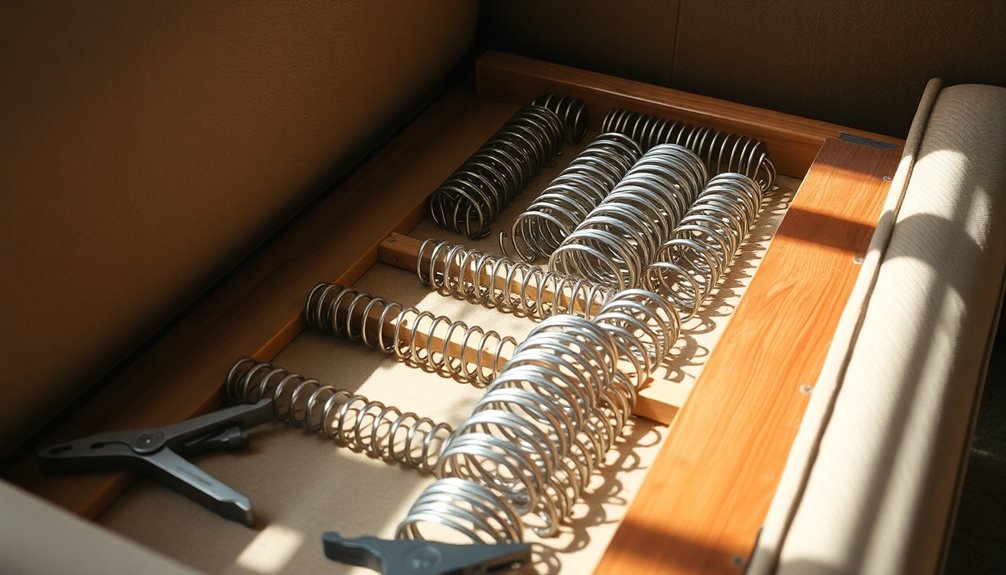
To ensure your couch remains sturdy, start by flipping it over and checking for any signs of frame weakness. Tighten loose joints and assess the alignment to prevent sagging and improve your seating experience. Once you've addressed these issues, you can think about reupholstering any worn fabric sections for a fresh look.
Frame Weakness Assessment
Assessing the stability of your couch frame is crucial for ensuring its longevity and comfort. Start by flipping the couch over to inspect the frame for any visible cracks, breaks, or signs of wear that might indicate weakness. Pay close attention to the joints where the frame pieces meet; they should be securely fastened. Loose or damaged joints can compromise overall stability.
Next, use a level to check if your couch is sitting evenly. An uneven couch may signal frame issues you'll need to address. Apply pressure to various areas of the frame to test its stability. If you hear creaking sounds or notice any movement, these could be weak points requiring reinforcement.
Finally, make sure all couch springs are securely attached to their clips. Look for any overstretched springs, as they can compromise the couch's structural integrity. By conducting this thorough frame weakness assessment, you can ensure that your couch springs function well and provide the support you need. Address any issues you uncover to maintain a sturdy and comfortable seating experience.
Reupholstering Worn Fabric Sections
When you're ready to reupholster worn fabric sections of your sofa, it's essential to ensure the frame is stable and in good condition first. Start by removing the cushions and inspecting the frame for any breaks or damage. An unstable frame can lead to uneven wear on your new upholstery, so use a level to check that everything is even.
Next, look for weak joints in the frame. If you find any, reinforce them with wood glue or brackets to enhance durability. Don't forget to replace or repair any worn-out springs as well, since this will significantly improve the comfort and lifespan of your sofa.
After that, remove the dust cover to access the frame fully. This step allows you to check that all internal components, including springs and supports, are secure and in good condition. If everything checks out, you're ready to move forward with reupholstering. A stable frame is crucial for a successful project, ensuring your newly upholstered sofa not only looks great but also stands the test of time.
Revitalizing Your Seating Experience
Flipping your couch over and removing the legs gives you a clear view of the frame and springs, allowing for a thorough inspection. Start by examining the back of the couch for any visible breaks, displacements, or loose connections in the frame. These issues can compromise the stability of the springs and affect your overall seating experience.
Next, check that all serpentine springs are securely attached to their clips. Loose springs can lead to sagging and discomfort, which you want to avoid. Look carefully for any cracks or damages in the wooden or metal frame; replacing any compromised pieces is crucial to maintaining structural integrity.
Once you've identified any issues, reinforce the couch frame by reattaching the springs. Make sure they're properly tensioned to provide optimal support. This step is vital for revitalizing your seating experience, ensuring comfort and stability. By taking the time to address these frame stability checks, you'll enhance not just the durability of your couch but also the enjoyment you get from it. With a little effort, you can breathe new life into your seating area and enjoy your couch for many more years.
Cushion Density Adjustments
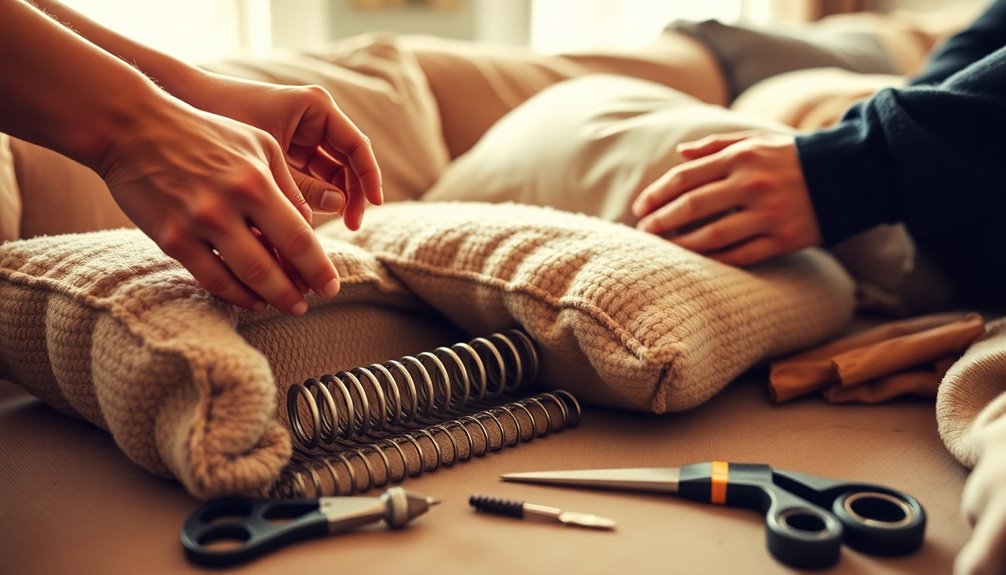
Cushion density adjustments can transform the comfort and longevity of your sofa. By altering the foam density, you can enhance support and minimize sagging over time. If your cushions are sagging, consider replacing the old foam with high-density options that range from 1.8 to 2.5 pounds per cubic foot for optimal support. This simple change can make a noticeable difference in how your sofa feels.
Another effective method is to rotate or flip your cushions regularly. This practice redistributes the filling, helping maintain density and extending the lifespan of your cushions. If you're not ready for a full replacement, adding a sofa topper made from high-density foam or memory foam can significantly enhance comfort without the hassle of complete cushion adjustments.
Additionally, don't underestimate the power of regular maintenance. Beating your cushions lightly can help loosen the filling, promoting an even distribution and preventing future sagging issues. By focusing on these cushion density adjustments, you'll not only improve your sofa's comfort but also ensure it stays supportive for years to come.
Routine Maintenance for Longevity
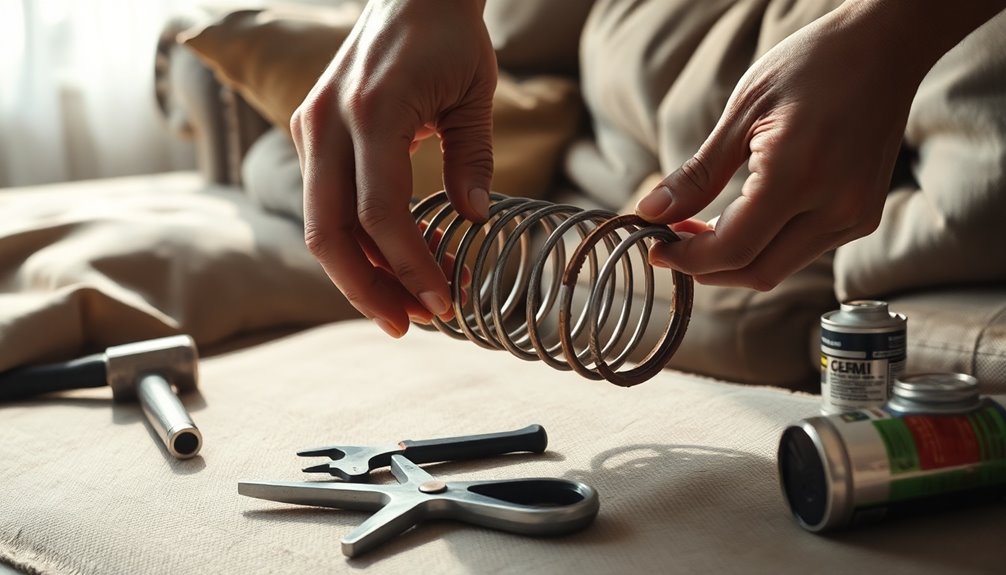
To ensure your sofa springs remain in top condition, make routine maintenance a priority. Start by regularly inspecting your sofa springs for signs of wear, like displacements or breaks. Catching these issues early can save you from more significant repairs down the line. Additionally, rotate and flip your cushions periodically to distribute weight evenly. This practice helps prevent sagging, which can put unnecessary strain on your springs.
Cleaning your sofa is another crucial part of routine maintenance. Dust and debris can accumulate and negatively impact the performance of your springs. Use a vacuum or soft brush to keep it tidy. If you notice any loosening in your springs, consider reinforcing them with wire or twine for added support. This simple fix can significantly prolong their lifespan.
Finally, think about using a sofa topper or additional padding as a temporary solution. This will maintain comfort while keeping pressure off the springs. By following these routine maintenance tips, you'll help ensure your sofa springs stay strong and functional for years to come.
Conclusion
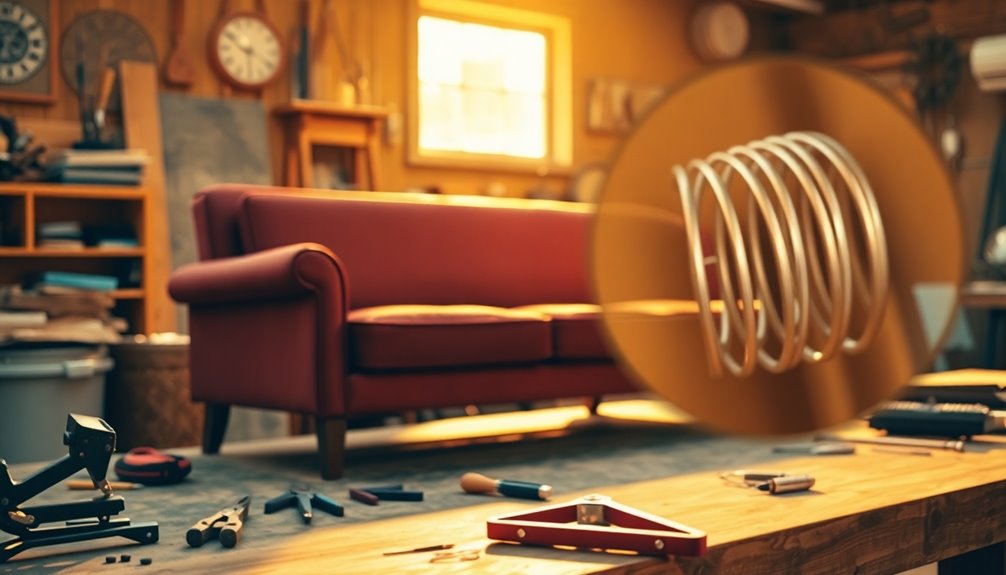
Maintaining your sofa springs through regular inspections and care can save you time and money in the long run. By addressing issues early, you can avoid the hefty cost of a new couch, while ensuring your current one remains comfortable and supportive.
When you notice any signs of wear, such as sagging or creaking, take the time to inspect the springs. Detaching broken springs and replacing them with new ones from a repair kit, like the 31Pcs Couch Spring Repair Set, can be a straightforward fix. Remember to secure those spring clips properly, cut springs to the right length, and hang them for optimal tension and support.
Reinforcing existing springs with wire or twine offers additional support and can significantly prolong the life of your sofa. Don't forget about routine maintenance, like flipping and rotating cushions, to help minimize sagging and keep everything in shape.
Frequently Asked Questions
Can Springs in a Sofa Be Repaired?
Yes, you can definitely repair the springs in your sofa. If they're broken or overstretched, you'll need to detach and replace them. Start by flipping your couch over and removing the legs for easier access. Once you've got a good view, you can secure the intact springs back to their clips. For extra support, consider reinforcing them with wire or twine. This can really help prolong your sofa's lifespan and comfort!
How Much Does It Cost to Replace Sofa Springs?
When you're looking to replace sofa springs, costs can vary widely. Typically, you can expect to spend between $100 and $300, depending on the complexity of the repair. If you decide to go the DIY route, spring repair kits usually range from $20 to $60. Keep in mind that hiring a professional could add labor fees of $50 to $150, so weigh your options carefully to find what works best for you.
How to Fix a Sagging Couch Spring?
To fix a sagging couch spring, start by flipping your couch over and removing the legs for better access. Check the springs for breaks or displacements; if you find any, replace them with new springs from a repair kit. Secure the intact springs to their clips, reinforcing them with wire if needed. If the sagging continues, consider adding more tension springs for extra support. Finally, reassemble the couch for stability and a neat appearance.
How to Fix a Couch That Sinks in the Middle?
If your couch sinks in the middle, start by checking the cushions. Flip or rotate them to redistribute the filling and gently beat them to loosen any compressed material. If that doesn't work, consider adding extra stuffing like foam to the sagging areas. A sofa topper can also provide temporary support. Regularly rotating your cushions and inspecting the structure can help prevent future sagging and keep your couch comfortable longer.
